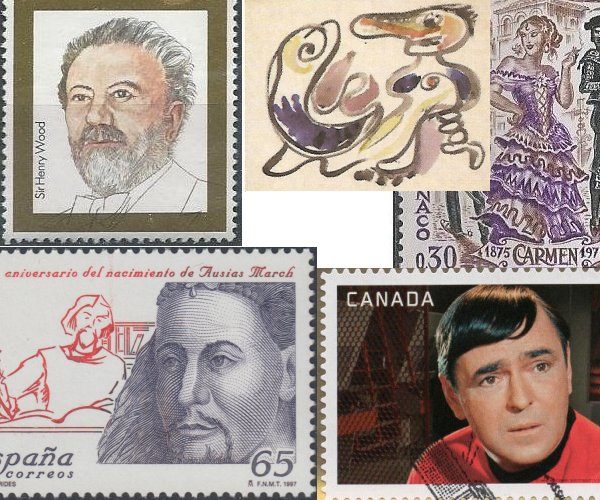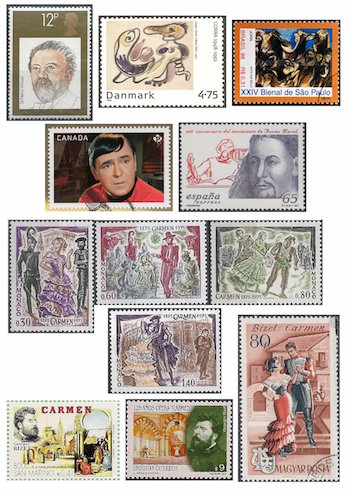The Arts on the Stamps of the World — March 3
An Arts Fuse regular feature: the arts on stamps of the world.

By Doug Briscoe
Our birthday subjects for this March 3rd are English conductor Sir Henry Wood, Danish artist Asger Jorn, and Canadian actor James Doohan—”Scotty” on Star Trek. 3 March was also the date on which the Valencian poet Ausiàs March died in 1459 and on which Bizet’s Carmen was first performed in 1875.
Sir Henry Wood (1869 – 19 August 1944) was beloved as the leader for half a century of the London promenade concerts, the “Proms.” He could have been the music director of the New York Philharmonic or the Boston Symphony (which latter he regarded as the best orchestra in the world), but remained in the UK because he felt it his duty to serve British music, particularly in light of the fact that the invitation from Boston came toward the end of World War I. Wood’s father was an amateur cellist and lead tenor in the church choir, and his mother played piano. Young Henry learned that instrument at her instruction and became enamored of the sound of the organ at church, where he learned well enough to give a solo recital (at another church) at the age of ten. By the time he entered the RCM, however, he aspired to be a teacher of singing, which he pursued with great success all his life. He worked as a répétiteur with Richard D’Oyly Carte, composed an oratorio and two operas, and took up the baton, at first as a choral conductor. In 1892 he conducted the first British performance of Tchaikovsky’s Eugene Onegin. When Robert Newman founded the Queen’s Hall Promenade Concerts in 1895, he engaged Wood as conductor. From the start, Wood began to introduce weightier music into these “light” concerts. He gave the British premières of a great many important scores and more than a hundred new British works between 1900 and 1910 alone. Several of these were his own compositions, the Fantasia on British Sea Songs in particular becoming a Proms favorite. Wood was solicitous for the welfare of his musicians and introduced women into the orchestra in 1913 (by 1918 there were fourteen of them). He was knighted in 1911. Forty years later, the Queen’s Hall was destroyed in the Blitz, and the Proms moved to the Albert Hall, where they have remained ever since. Sir Henry was too ill to conduct the fiftieth anniversary Proms concert on August 10, 1944, and he died nine days later. I must omit many fascinating details of a fascinating life.

Danish artist Asger Jorn (1914 – 1 May 1973) went through a number of personal and intellectual crises in his life, beginning with a rejection of his parents’ firm religiosity (and similar forms of authority), then a bout with tuberculosis when he was fifteen, later a flirtation with and renunciation of Communism (though he remained sympathetic to Marxism), and a depression resulting from the Nazi occupation of his homeland. But life wasn’t all a bowl of cherry pits for him. As a youth he took a keen interesting in painting and was given a remarkable accolade by the principal of his college, who wrote that Jorn had developed “an extraordinary rich personal development and maturity,” largely through his voracious reading in diverse subjects. He found a substitute father figure in the syndicalist Christian Christensen and drove a motorcycle to Paris to study with Kandinsky and Fernand Léger, later working with Le Corbusier at the 1937 Paris Exhibition. Back in Denmark, he undertook further studies at the Royal Danish Academy of Fine Arts in Copenhagen. During the occupation, he joined the resistance and co-founded an underground art group. He also co-founded the European avant-garde art movement COBRA (named for the founders’ home cities of Copenhagen, Brussels, and Amsterdam) and the curiously titled Scandinavian Institute of Comparative Vandalism, which sought to study the cultural influence of the Vikings through their diasporic migrations. Jorn’s intellectual diversity also resulted in books on philosophy and political economy, and he was the first to translate Kafka into Danish. As for his work in the visual arts, he worked not only in painting but with sculpture, ceramics, collage, tapestry, etc. We see two of his works son stamps: Untitled (1931) on a Danish issue in recognition of COBRA and The Raft of the Medusa (1950) on a Brazilian stamp issued for the 24th São Paulo Art Biennial on 1998. There is a Jorn Museum in Silkeborg, Denmark, for those wishing to investigate further.
James Montgomery Doohan (1920 – July 20, 2005) is immortalized as “Scotty” on Star Trek. For that program he made number of other contributions, for example, he provided voices for various aliens/entities (e.g., Sargon in “Return to Tomorrow” and the M-5 in “The Ultimate Computer”) and had a hand in the early development of the Klingon and Vulcan languages. Doohan was born in Vancouver and was severely wounded by friendly fire on Juno Beach on D-Day. One of the injuries severed his right middle finger, a loss he always concealed in his acting roles. He was married three times and had seven children. The stamp comes from the same Canadian set, issued last year for the 50th anniversary of Star Trek, from which we saw the Deforrest Kelley stamp last month.
Next we turn to the medieval poet Ausiàs March (I gather the Valencian pronunciation of this is sounded like “mark”, and the esses in his first name are vocalized). He was born to the nobility in or about 1400 and died on this date in 1459. His father, who died when March was only 13, was also a poet. Other than taking part in certain Mediterranean expeditions in 1427, he never left his native region. His verse, written in the local vernacular rather than the Occitan of the troubadours, is modeled closely on Petrarch without sacrificing originality. Some of his poetry was set to music in the next century by Joan Brudieu and in our own time by the Spanish singer Raimon (Ramon Pelegero Sanchis, born 1940).
Bizet’s beloved Carmen was not beloved when it premièred at the Opéra-Comique in Paris on 3 March 1875, although the first act seems to have gone well. This most popular of operas had to wait until some years after Bizet was dead to attain its popularity. For the centenary, Monaco issued this beautiful set of four stamps depicting various scenes from the opera. The Hungarian stamp, from 1967, is one of a set of eight celebrating famous operas. Much more recent are the issues from San Marino (1999) and Uruguay (2000).
A graduate of the University of Massachusetts with a B.A. in English, Doug Briscoe worked in Boston classical music radio, at WCRB, WGBH, and WBUR, for about 25 years, beginning in 1977. He has the curious distinction of having succeeded Robert J. Lurtsema twice, first as host of WGBH’s weekday morning classical music program in 1993, then as host of the weekend program when Robert J.’s health failed in 2000. Doug also wrote liner notes for several of the late Gunther Schuller’s GM Recordings releases as well as program notes for the Boston Classical Orchestra. For the past few years he’s been posting a Facebook “blog” of classical music on stamps of the world, which has now been expanded to encompass all the arts for The Arts Fuse.
